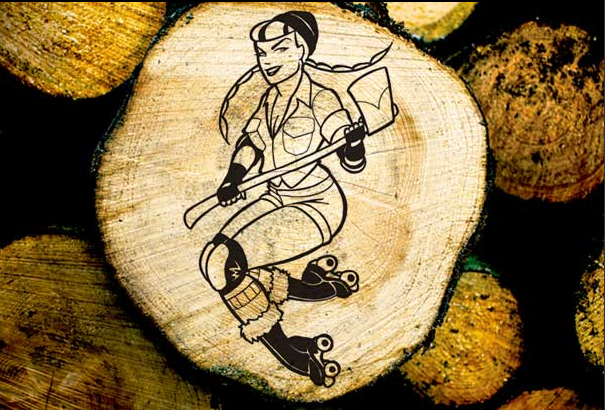
In roller derby, the jammers may be the 'stars' of the show, but we all know where the real excitement is: Big. Fat. Hits.
It's what birthed our very sport, it's what the fans came to see, it's the blocker's bread and butter and it puts the quake in a jammer's knees on the start line.
So how do you hit really hard? Particularly if you're small? With the help of some other skaters, I've broken down the key elements of effective blocking for you.
Find your centerFirst and foremost, you've got to get balanced, and balance comes from two things: proper skating stance and core strength.
A proper skating stance is one that's low and wide. You knees should be deeply flexed, your ass should be down, not up in the air, and your torso should not be hunched over your thighs. You should always be centered in relation to your skates. You'll notice that if you ever get the majority of your body weight in front of your toes, behind your heels, or past your outside wheels on either skate, you become unstable. So first, make sure your stance is solid, and that you're comfortable staying centered, even when you are putting more weight on one skate than the other.
The second element of balance, and the one that tends to get overlooked is core strength. What is your core? Simply put, it's the very center of your body and the power source behind any thing you do that transfers momentum. Your body core is made up of the muscles in your abs, hips, glutes and lower back.
Consider a baseball player throwing a ball, a golfer swinging a club, or a soccer playing kicking a long pass. The power for these actions doesn't come from the arms or legs alone, or even primarily. The power comes from the core. Twisting the torso, driving the hips and contracting the abdominals all provide the necessary force.
The same is true for blocking in roller derby. You don't hit someone with your shoulder, you hit them with your whole body, contracting and expanding your core like spring to put the 'pop' in a J-block. The power to veer into a check doesn't just come from your legs, it comes from driving your hip toward your target.
You can build up your core by working your abs, your lumbar region, your glutes and your hip flexors and abductors. There's plenty of info on the net about how to do this but a sampling of effective exercises would include crunches and side crunches, leg lifts, back hyperextensions, seated rows, kickbacks, side lunges and wide-legged squats. A personal trainer would be a huge help in targeting these areas, but with some preparation and discipline you can also do it effectively on your own.
Bodybuilding.com is an awesome resource to find exercises that target specific muscle groups and the options run the gamut from body weight and free weight exercises to machine exercises.
Don't sweat the techniqueMake sure you know your basic blocking form. Familiarize yourself with the J-block (rising into a block from a squat when using the shoulder), the correct form for a hip check (more on that later), and how to properly execute a can opener. Have an advanced teammate or coach watch you and critique your form so you're not wasting energy practicing the wrong moves.
Be light on your feetFootwork is probably more important to effective blocking than size. No matter how big you are, if you skate like a bus low on steering fluid, you probably won't hit anyone because they'll have all day to get out of your path.
Blocking power can come from speed instead of mass, so use your skating skills to your advantage. You have probably done drills where you cut from one side of the track to the other, or where you veer through cones placed in a wide zig-zag pattern. That's the move you need to use, that quick cut from one side of the track to the other.
Make sure you lead with the foot that's on the same side you are blocking toward. Turn that toe and knee out toward your target and focus the weight on that foot into the outside of your heel. You should be able to lift your front wheels clear off the floor once you get comfortable with it. At the same time, dig in with your other foot and carve a half circle toward the side you are blocking on, like when you skate with all eight on the floor. The weight in that skate should be focused on the inside edge and you should push through the heel, almost pivoting on the front wheels.
Really drive your hips into it like you're skiing and remember that the deeper you scissor your legs from front to back and from side to side, the faster you can cut. Lead into it with your hip and really commit to the block.
Again, make sure you are skating in a proper stance. This makes you hard to knock down, and when you're hitting someone, most of the time it's the lower, more stable skater who will stay on their feet.
Good footwork is not just important in performing a block, but in strategically lining one up as well. If you can intersect a skater much faster than she can anticipate, you will have the upper hand. Work on moving around the track quickly, by veering, hopping, crossing over and running through corners to build the type of explosive agility that will catch opponents by surprise.
Block smarter, then harderUse the corners to your advantage. When you block with a quick cut from the inside of a corner to the outside, where centripetal force is on your side, you don't need a ton of power to knock down a larger skater, and a smaller skater is often easily floored.
Watch for the way the pack often stretches out into a near line around corners, particularly with newer leagues/skaters, exposing an irresistible hole to a jammer taking the outside. Meet her in the middle of this gap and give her your regards.
If you're smaller, don't forget you can work with your teammates on whipping and pushing you into blocks for more power. This is especially effective if you have a 1-2 blocker combo where you have a larger, power hitter, and a smaller, agile blocker. The power blocker can take on the big girls and focus on forceouts, and the agile blocker can move quickly for surprise hits or to get in front of a jammer for a positional block, lining her up for a takeout by the power hitter. The bigger skater knows to whip and throw the smaller skater into the jammer, and the smaller skater knows to use the bigger skater as a screen and line up hits for her.
Less can be moreI love putting girls on the floor as much as the next derby player, but don't forget that as a blocker, your job is not always to knock opponents down, nor is it always the best use of your energy. If you can distract an opposing blocker or draw her out of position with a quick jab of your hip or shoulder so your jammer can sneak by, then save your steam for when you really need to make somebody polish the sport court.
Use 6.2.10 to your advantageMake the opposing skater, particularly the jammer, cut the track by blocking her to the inside, especially on the corners where she can easily re-enter illegally before she can stop herself. I've also seen lots of blockers hit a jammer out of bounds and then slow almost to a stop, making her wait to re-enter or get the penalty. Although personally, I think it's a rule loophole that will likely be fixed in a future revision, you will usually get away with it.
Be sneakyThe hardest hit is the one you don't see coming. So hit girls on the side they aren't looking on. A great place to do this is on the corners when blockers look over their left shoulders for the jammers. As soon as you see the back of an opposing blocker's helmet, knock her into the infield.
Be unpredictableDon't telegraph your block by looking at the girl you want to hit, tensing your body, and lining her up. She will see it coming a mile away and you'll whiff the block big time. Use your peripheral vision and work on your timing, so you can move at the last second and still connect.
Be ruthlessUse your strongest weapons against their weakest points. In roller derby that usually means a hip check to the mid thigh. You'd be surprised at how many skaters you can take out with a hard block, low in the legal zone, when you could shoulder check them all day and just bounce off.
A great way to use a hip check is actually to aim for the inside of the opposing skater's thigh, on her outside leg. So you actually cut in front of her body and hit on the inside of her leg instead of hitting her in her side. Time it right and it will usually take a skater right out.
Take that, rewind it backIf you want to take your blocking to the next level, do yourself a favor and learn to block backward. Not only in the sense of blocking to the front of the body, but in the sense of making a quick and very sharp veer that carries you at a 90 degree angle toward another skater. Master this move so that you are just this side of actually skating clockwise to block and savor the surprise of your enemies.
Charge the front lineI can't stress enough how important blocking to the front of the body is. I don't even try to check girls shoulder to shoulder anymore because it's a waste of my energy. Instead, I focus on using my shoulders to hit girls in the chest, or if you get low and swoop upward, in the solar plexus, which is even better. For hip checks, hit them in the front of the thighs, crotch, or stomach, which will really mess up their skating stance and force them out of balance. The can opener (using your shoulder to strike backward against the front of an opposing skater's body) is an absolutely indispensable move that every skater should master.
Bring the painLastly, don't be afraid to hurt somebody. Legally, of course.
Far too many new skaters under-commit to blocks, pulling back at the last second. If you've never practiced checking a blocking pad, try it. It helps let go of the anxiety of injuring someone and lets you feel the full power of your efforts and determine where you need more follow through. Borrow a little wisdom from martial arts and imagine your target on the other side of the skater or blocking pad you are hitting. Don't strike
at your target, strike all the way
through it for maximum power.
Excluding scrimmage and drills where you are told to block at low power, don't be scared to open up your entire can of whoop ass and serve it cold with a straw. It's a great compliment to another skater to clean her clock, and to borrow a bit more from martial arts, kendo practitioners talk about the zen involved in receiving a really hard hit, because for one second, their mind is completely clear. Make 'em say 'om'.
Portions of this article were originally posted in a thread on the Skatelog forums. Special thanks to the participants of that thread, some of whose ideas have been incorporated here.













